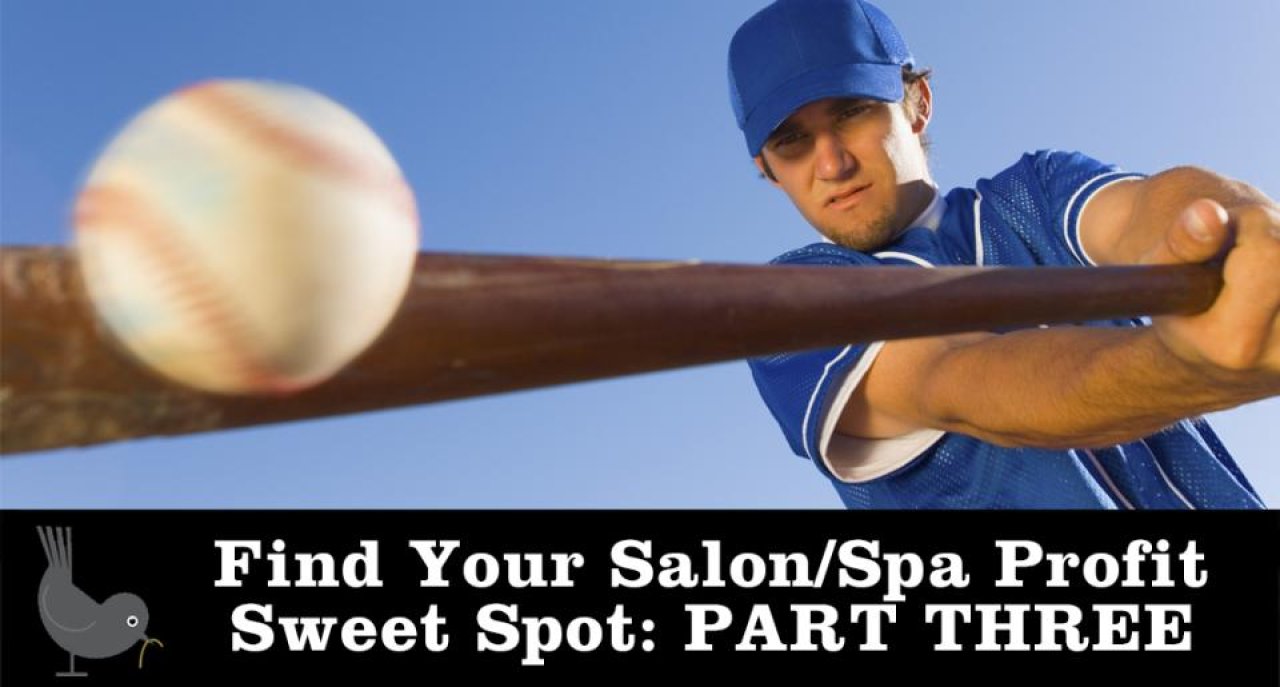Finding Your Salon/Spa Profit Sweet Spot: PART THREE

Profit is the end result of a number of critical operational and financial disciplines. Think of it as an on going dialing in of systems, performance, information flow and a relentless commitment to paying attention to your numbers.
Here is a 7-point No-Compromise Leadership hit list that will help you dial-in and lock-in your salon/spa’s profit sweet spot:
- Polishing your crystal ball: Some owners simply struggle when it comes to projecting service revenues and have little faith that their “best guesses” are achievable. Others take a simplistic tactic of adding a percentage increase over last year’s sales. The most deadly accurate approach of projecting service revenues is to determine each month’s available service hours for sale based on the expected service provider work schedules. Ten stylists working 40 hours per month x 4.3 weeks = Total projected hours for sale. (10 x 40 x 4.3 = 1,720 hours for sale) Next, multiply the projected monthly hours by the productivity rate you want to achieve for each month. If you’re shooting for an 80% productivity rate, the calculation looks like this; 1,720 hours x 80% = 1,376 projected hours sold. The last step is to multiply expected hours sold by how much one hour of service can generate. If one hour can generate $85, it looks like this; 1,376 x $85 = $116,960 in total service sales. Do this for each month for each service department. If you hire more staff in one month, add those hours. If you believe you can drive productivity higher in one month, multiply by a higher productivity rate. If you raise prices, increase your revenue per hour. Retail sales projections are simply your projected percentage of total revenue.
- Selling hours and selling stuff: Once you have your revenue projections, it’s time to put the urgency and energy into driving those projections. This means daily information flow in the form of huddles, scoreboard tracking and keeping your team focused, engaged and on their game. Using the formula above, it’s easy to explain where the projected revenues came from. It would sound like, “We based our projections on hours for sale (everyone showing up for work), multiplied by our target productivity rate, multiplied by what an hour of service can produce in sales.” Information flow, huddles and scoreboards focus on the team goal rather than what each column on the appointment book can generate. Individual goals are fine, but when individual goals overshadow team goals … “I/me/mine” thinking contaminates the energy of teamwork.
- Prebook and client retention: Because salon/spa services are personal maintenance services, systems that drive prebook rates are a non-negotiable. Allowing a client to leave without making an effort to prebook is nothing short of squandering future revenues. The game is to fill the appointment book as far into the future as possible. And the better your prebook rate … the higher your first-time and existing client retention rates. Prebook and client retention are crucial profit drivers.
- Contain the Beast: What beast am I referring to? Payroll … that’s the beast. But it’s a three-headed beast. The really nasty head is service payroll … payroll for hands that do the work. It’s your single largest expense percentage. On a Profit & Loss Statement, the Strategies benchmark for service payroll is 30% to 35% of Total Service and Retail revenue. (This is not referring to a percent of service sales only, or suggesting 30% to 35% commission.) The more service payroll exceeds 35% on your Profit & Loss Statement, the more it is out of control. The next head of the beast is Administrative/Guest Services payroll cost. This beast should live between 8% and 10% on your Profit & Loss Statement. The last head of the beast is “officer’s/owner’s payroll.” There are a number of factors to consider with this beast, including if the owner is also a service provider. The Strategies benchmark is approximately 10%. Strategies’ expertise is in containing the payroll beast. NOTE: If you're looking for the single-best strategy for retaining your service payroll and motivating your staff to grow the business, check out Strategies Team-Based Pay compensation system.
- Purposeful purchasing: Making purchases without a budget is surrendering profit to chance. Professional use and retail product purchases should be planned, approved and managed. Buy the gotta have’s first and the nice-to-have’s last. If you don’t have the cash in the bank to buy what you need, you’re forced to buy on credit or borrowed money. If you can’t pay off credit card balances every month, credit card debt is going to accumulate fast at interest rates not far from loan shark rates. If you’ve got your eye on bigger purchases, like equipment, and you’re tight for cash, you must ask yourself this question, “Do I need this so bad that I’m willing to incur debt to get it?” Almost all serious credit card and debt messes are the result of poor planning, impulse buying and outright avoidance of financial disciplines. Forget to plan and budget … and forget about profit.
- Actual vs. plan: There is no greater financial tool than using a Cash-Flow Plan that shows actual costs versus plan. Strategies has been teaching and coaching Cash-flow planning for over 22 years and it’s the one discipline that owners push back on most. Plan it before you spend it. Control it before it gets out of control. Plan for profit and you have the best chance of achieving profit.
- Stash the cash: The money in your checking account is for paying expenses. The best rule to follow is, if it’s in the checking account … it’s going to get spent. Build your cash reserves by sweeping cash into a savings or money market account. That’s the only disciplined way to build cash reserves. And here’s something to chew on and digest; If you don’t have three to four months of operating expenses in cash reserve … your company is fully exposed to even the smallest financial crisis.
Is your stomach in knots after reading this? Have no fear, you're already on the right path by acknowledging that you need to make some changes.
So where can you learn how to do all this stuff? Well, we don't just write about this stuff, we also teach it in our coaching and seminar work. And the Strategies Incubator Seminar is the best place for you to start implementing ALL these systems and more. We can guarantee you it will be the four most important and enlightening days as a salon/spa owner. Visit strategies.com/seminars for upcoming Incubator dates.
Read Part One of this post here: Disciplines of Creating Salon/Spa Profit: PART ONE
Read Part Two of this post here: How Systems Drive Salon/Spa Profit: PART TWO
- - - - - - - - -
Please share your thoughts with me about today's Monday Morning Wake-Up. Click below to comment.
Pass this e-mail on to your business colleagues, managers and friends. They will appreciate it.


Comments
No comments found. Start the conversation!
Leave a Comment